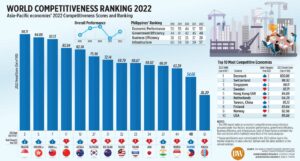Time for more aggressive monetary action

It’s good to connect two seemingly unrelated pieces of news from the broadsheets.
The first is from the ASEAN + 3 Macroeconomic Research Office (AMRO) based in Singapore which upgraded its growth forecast for the Philippines from 6.5% to 6.9% this year. The second is that the Bangko Sentral ng Pilipinas (BSP), after advancing the implementation of its monetary policy exit plan from the 3rd or 4th quarter this year to as early as May 19, announced that it was prepared to adjust its policy rate more than the usual 25 basis points.
AMRO’s reasons for the upgrade actually provide the link. First, the first quarter growth was spectacular at 8.3% due to the broad reopening of the economy. This would be a good foundation not only for future growth but also for resiliency against future shocks. Second, because of this, AMRO believes that “growth is self-sustaining (and) it’s prudent for the BSP to raise rates now in order to create more head room for the economy in case there’s another shock and they need to lower the rates.”
Creating monetary space is growth-positive, something that justifies ending patience in the conduct of monetary policy. For the dovish at heart, AMRO assured that “we don’t think that the increase in the interest rate or policy rate will have a significant impact on growth this year or next year.”
What is AMRO trying to say here?
The Philippines is poised for some good recovery starting in the first quarter of the year. Even if the BSP should decide to tighten monetary policy to gain more traction in the event of another shock, the economy is robust enough to withstand more aggressive monetary action. AMRO could only cite potential risks to growth in the ASEAN including the sustained rise in energy and food prices, supply chain disruptions, sharper-than-expected China slowdown, aggressive monetary tightening in the US, and resurgence of the pandemic.
In short, an appropriate monetary tightening is not inconsistent with economic recovery and sustained growth in the Philippines.
In theory, monetary policy tightening is imperative in the Philippines today because the supply shocks coming from high fuel prices and supply disruptions have already produced second-round effects. The evidence is clear that wage increases have been approved and implemented in nearly all regions in the Philippines. This is a continuing threat to price stability; more petitions for higher wages are forthcoming. Transport fares have also risen. With higher wages and transport costs, inflation is getting more entrenched. Cautious monetary policy is also necessary to promote financial stability and help prevent the peso from a free fall. Excessive volatilities of the peso could further firm up inflation.
AMRO argued, and we agree, that monetary tightening will not necessarily impede economic activities in a big way. The theory here is provided by the recently estimated flattening of the Phillips curve in the Philippines: a demand shock like a sharp reduction in the BSP’s policy rate is not expected to produce significant inflation. That was what happened in the two years of the pandemic. The sharp reduction in the policy rate and the phenomenal injection of excessive liquidity into the system produced little inflation partly because demand conditions were rather muted.
On the downside, however, if inflation exceeds the target, shepherding it back would require a greater tradeoff. Output could show a precipitous decline. The Philippines is precisely at that point where the first half 2022 average inflation at 4.4% has already exceeded the target. Forecasts for both 2022 at 5.0% and 2023 at 4.2%, are also in breach of the target. Normalizing monetary policy early on could have avoided “adding a layer” of complication to supply shocks and playing catch-up.
With the gathering momentum of domestic inflation, it was correct for BSP Governor Felipe “Philip” M. Medalla to abandon the gradualist approach and embrace a more aggressive monetary policy. If the exchange rate volatilities should persist, nothing prevents the BSP from implementing some macro-prudential measures. But more crucial is the possible bigger-than-usual policy rate adjustment of more than 25 basis points. As the BSP chief clarified on Monday: “We are a lot more concerned about the inflation effects of a more depreciated peso given that we already have very high inflation.”
Yes, the exchange rate pass-through after the BSP’s switch from monetary aggregate targeting to flexible inflation targeting (IT) in 2002 has been found to have dropped. Part of the reason is the BSP’s increasing ability to deliver on its price stability objective and firmly anchoring inflation expectations. Thus, the signal value of the exchange rate has been reduced, with the market perceiving exchange rate shocks as merely transitory. Firms then tend to moderate the exchange rate-induced increase in output cost that they pass on to selling prices to protect their market shares. Another interesting empirical evidence is the asymmetrical effects of the exchange rate on inflation. Prices tend to adjust more slowly to currency appreciation but much faster when it depreciates.
Today, we have a situation in which actual and projected inflation rates are breaching the official target of 2–4%. Simultaneously, the peso has depreciated by nearly P3 in less than 30 days. Yet our real effective exchange rates (REER), whether overall, against our major trading partners or against developing country competitors, continue to trend up suggesting a weakening of our external competitiveness. It’s not enough to have a weak currency, it’s also important to maintain low and stable inflation.
Governor Philip also mentioned the need to re-anchor inflation expectations. The rate at which economic agents like consumers and businesses expect prices to increase in the future, inflation expectations are important because actual inflation is also partly driven by our own view.
Based on the results of various surveys of consumer and business sentiments, economists and forecasters, inflation expectations can be influenced by both central bank monetary action, especially if appropriate and decisive, and more recently, central bank communications. Keeping inflation expectations anchored means the public normally ignores short-term shocks even upward blips in actual inflation. If successful, it allows the monetary authorities to respond appropriately to inflationary demand shocks without motivating the so-called wage-price spiral.
In the Philippines, we have observed that inflation expectations after 2002 have become more forward-looking. In our previous research, this means the impact of previous inflation has declined relative to that of expected inflation. Forecasts and expectations have become important while central bank communications could help either anchor or de-anchor inflation expectations. Based on this, the recent BSP forecasts indicating overshooting of the inflation target could lead to de-anchoring of inflation expectations away from the target. However, Governor Philip’s strong statement should be able to recast them into conditional propositions: the BSP will do what it takes to bring inflation back within target.
Which brings us back to our column of April 7 (“Ensuring orderly inflation expectations,” BusinessWorld). We quoted there the eminent London School of Economics and Political Science economist Charles Goodhart and Manoj Pradhan of Talking Heads Macroeconomics (“What may happen when central banks wake up to more persistent inflation?” Center for Economic Policy Research, October 2021) who suggested that although necessary “a sudden policy reversal could lead to severe downturns in financial markets and significantly damage public sector balance sheets.”
The way out of such a dilemma is precisely to prepare the public by way of one, symbolic tiny steps in monetary tightening and two, convince the market “that an orderly evolution is not just possible, but likely.”
The BSP that we are seeing today has taken those baby steps, communicated its policy intent that is conditional to sustained price increases and exchange rate volatilities, and conveyed that it’s now on a warpath against inflation.
It’s about time.
Diwa C. Guinigundo is the former deputy governor for the Monetary and Economics Sector, the Bangko Sentral ng Pilipinas (BSP). He served the BSP for 41 years. In 2001-2003, he was alternate executive director at the International Monetary Fund in Washington, DC. He is the senior pastor of the Fullness of Christ International Ministries in Mandaluyong.




